Ballooning: It’s a Gas!
What makes a hot-air balloon fly? The answer couldn’t be any simpler: Warm air rises. Period.
Of course, the details of how to generate the heat, harness the hot air, and control a balloon in flight make the sport of ballooning a far more complex matter. But the underlying principle is simple enough.
The Air That You Heat
If you weigh two equal – size parcels of air that are at different temperatures, the warmer one will weigh less. For example, if you fill one large trash bag with cool air from your basement, and fill another one with hot air from the attic, the one filled with attic air will weigh less. Of course, a trash bag only holds a couple of cubic feet of air weighing about a pound, so you’d need a pretty sensitive scale to measure the tiny difference!
But when you start talking about a bag of air holding from 70,000 to 100,000 cubic feet of air standing seven stories high or taller, and measuring more than 50 feet across, the difference in weight becomes considerably more measurable. And on this enormous scale, the buoyant effects of warm air are amplified exponentially.
|
|
The air inside a hot-air balloon is heated by propane flames shooting from the nozzles of liquid propane gas tanks. The tanks range in capacity from 10 gallons to 20 gallons each. Burning between 30 and 40 gallons of propane per flight, the burners generate 10 million to 30 million British Thermal Units, or BTUs.
The flames generated by the propane burners keep the air inside the balloon’s envelope much hotter than the surrounding air even on a warm summer day. The difference in temperature between the air inside the envelope and the air outside it becomes even more pronounced in the cool hours of the morning and evening, when balloon pilots prefer to fly because of generally calmer wind.
The Envelope, Please
|
By the Book A balloon’! envelope is the bright, colorful, sometimes oddly shaped nylon or polyester fabric bag that contains the hot air that keeps the balloon aloft. |
The balloon’s envelope is coated with a layer of polyurethane impregnated with chemicals like silicone or neoprene to fill in the natural pores in the cloth and hold in the hot air better. The air inside a balloon reaches temperatures of over 200°F—pretty hot, but not hot enough to ignite the envelope material. Often, designs, logos, or slogans are placed on the outside of the envelope using an applique technique that lets balloon owners and sponsors create words and designs large enough to fill a billboard. As we touch on later, the sport of ballooning is not exactly immune to the commercialization craze.













